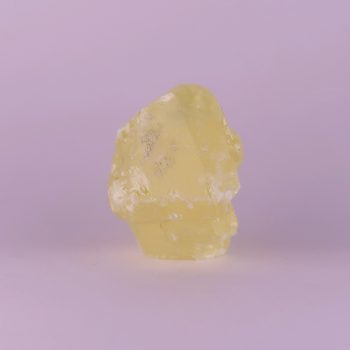Sulphur
Sulphur is an element, number 16 on the periodic table. It forms very pretty canary yellow crystals.
The crystalline form is relatively rare – with excellent quality specimens from Italy, Russia, Poland, and a few more locales.
Showing the single result
Information about Sulphur
Sulphur (sorry, I am British – it is not sulfur to me!) is a bright yellow, non-metallic mineral that typically forms as orthorhombic crystals or as earthy, granular, or powdery masses.
Its crystals are often well-formed and may exhibit transparent to translucent clarity. This, combined with its bright yellow colour can make crystalline sulphur deposits extremely fine mineral specimens.
Sulphur is commonly found near volcanic vents, hot springs, and salt domes, where it precipitates from gases containing hydrogen sulfide (H₂S). It can also occur as an oxidation product of sulphide minerals like pyrite or galena.
Uses and History
Sulphur has been an essential material throughout human history and remains vital in modern industry.
It is primarily used in the production of sulphuric acid (H₂SO₄), a key chemical in fertiliser manufacturing, petroleum refining, and mineral processing.
Other significant uses include vulcanising rubber, producing gunpowder, and creating fungicides, insecticides, and pharmaceuticals.
Sulphur is also used in cosmetics and as a food preservative. Additionally, elemental sulphur is sometimes used in soil amendment to correct alkaline soils.
Sulphur has been known since antiquity, with references to its use appearing in ancient texts, including the Bible and Greek writings.It is probably best known biblically from the story of Sodom and Gomorrah, or from “fire and brimstone” preachers.
The name “sulphur” is derived from the Latin word sulphurium. It was historically used in the production of incendiary weapons like “Greek fire” and in alchemy.
During the Industrial Revolution, sulphur became vital for manufacturing sulphuric acid, earning the nickname “the king of chemicals.”
Natural sources of sulphur, such as volcanic deposits, were historically important, though most modern sulphur is produced as a byproduct of petroleum refining and natural gas processing.
Mineralogy
Typically bright yellow but may appear yellow-brown, greenish, or red when impure.
Hazards and Warnings
Produces sulphur dioxide if burned, which can irritate the respiratory system.
Mineral collectors should wash their hands after handling specimens, to avoid any exposure to potential toxins.
Almost all rocks, minerals (and, frankly, almost all other substances on earth) can produce toxic dust when cutting, which can cause serious respiratory conditions including silicosis.
When cutting or polishing rocks, minerals, shells, etc, all work should be done wet to minimise the dust, and a suitable respirator or extraction system should be used.
Translations
Arabic:
- الكبريت
Hindi:
Portuguese:
- Enxofre
Bengali:
Indonesian:
- Belerang
Punjabi:
English:
Italian:
- Zolfo
Russian:
- Сера
French:
- Soufre
Japanese:
- 硫黄
Spanish:
- Azufre
German:
- Schwefel
Korean:
Thai:
- กำมะถัน
Gujurati:
Mandarin Chinese:
- 硫磺
Urdu:
- گندھک

